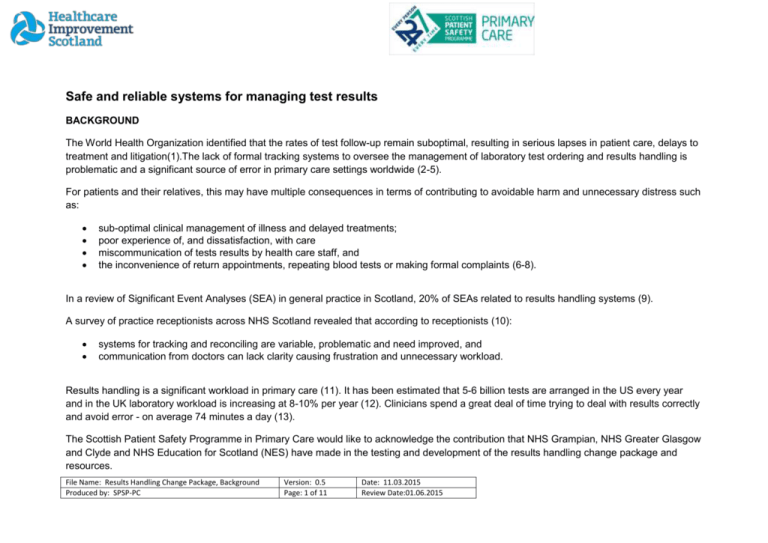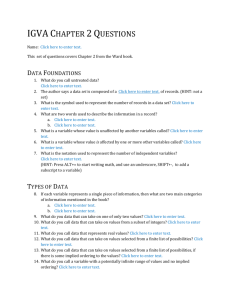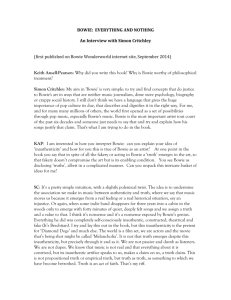Results Reconciliation - Carronbank Medical Practice
advertisement

Safe and reliable systems for managing test results BACKGROUND The World Health Organization identified that the rates of test follow-up remain suboptimal, resulting in serious lapses in patient care, delays to treatment and litigation(1).The lack of formal tracking systems to oversee the management of laboratory test ordering and results handling is problematic and a significant source of error in primary care settings worldwide (2-5). For patients and their relatives, this may have multiple consequences in terms of contributing to avoidable harm and unnecessary distress such as: sub-optimal clinical management of illness and delayed treatments; poor experience of, and dissatisfaction, with care miscommunication of tests results by health care staff, and the inconvenience of return appointments, repeating blood tests or making formal complaints (6-8). In a review of Significant Event Analyses (SEA) in general practice in Scotland, 20% of SEAs related to results handling systems (9). A survey of practice receptionists across NHS Scotland revealed that according to receptionists (10): systems for tracking and reconciling are variable, problematic and need improved, and communication from doctors can lack clarity causing frustration and unnecessary workload. Results handling is a significant workload in primary care (11). It has been estimated that 5-6 billion tests are arranged in the US every year and in the UK laboratory workload is increasing at 8-10% per year (12). Clinicians spend a great deal of time trying to deal with results correctly and avoid error - on average 74 minutes a day (13). The Scottish Patient Safety Programme in Primary Care would like to acknowledge the contribution that NHS Grampian, NHS Greater Glasgow and Clyde and NHS Education for Scotland (NES) have made in the testing and development of the results handling change package and resources. File Name: Results Handling Change Package, Background Produced by: SPSP-PC Version: 0.5 Page: 1 of 11 Date: 11.03.2015 Review Date:01.06.2015 NES has reviewed and developed the evidence based guidance to inform the development of safe systems for ordering laboratory tests and managing results within UK General Practice and beyond (13). They concluded that: laboratory test ordering and results handling processes are a significant source of error and avoidable patient harm in international primary care there is a lack of, or inadequate, safety systems to guide ‘good practice’ and mitigate errors are common, creating risks for patients and GPs safety is created and risks minimised by introducing and standardising processes to improve the reliability of results management systems, and the practice culture must embrace a systems approach to this issue and a commitment to staff training and development. NES highlighted key steps in the process of ordering, taking and managing tests and developed 77 good practice statements in the steps summarised below (14): File Name: Results Handling Change Package, Background Produced by: SPSP-PC Version: 0.5 Page: 2 of 11 Date: 11.03.2015 Review Date:01.06.2015 PATIENT SAFETY IN PRIMARY CARE: Safe Laboratory Test Ordering and Results Management Systems Commitment to a System Approach and Improving Safety Culture Commitment to Staff Training and Raising Awareness of Roles & Responsibilities Ordering laboratory tests Managing results returned to practice Obtaining a sample Clinical review of laboratory results Administration of samples Results actioned or filed Transport to laboratory Patient informed and monitored through follow-up The Scottish Patient Safety Programme in Primary Care has developed a number of resources in this change package to reflect the evidence and to provide practices with tools. These will provide insights into how safe and reliable their practice systems are for managing test results, as well as practical suggestions to support improvement. File Name: Results Handling Change Package, Background Produced by: SPSP-PC Version: 0.5 Page: 3 of 11 Date: 11.03.2015 Review Date:01.06.2015 The resources include: measures for practices to collect regular data on the reliability of their systems questions to help practices discuss and explore their results handling systems sample communications that clinicians might use to communicate to staff and patients about what action needs to be taken after a result has been reviewed, and a leaflet and questionnaire that practices might adapt and use to help patients better understand the practice system for test results and to help practices learn about their systems from a patient’s perspective. Results Handling Rationale Measure 1 Rationale Are ALL the individual blood test(s) requested by the clinician clearly recorded? Errors associated with test ordering include failure to order the test and ordering an incorrect test. When a clinician makes a decision to obtain a test this should be clearly communicated to the appropriate personnel, preferably through appropriate computer software, where available. Source Wians FH. Clinical Laboratory Tests: Which, Why, and What Do the Results Means? Labmedicine 2009;40(2):105-113 (15) Elder NC, McEwan TR, Flach JM, Gallimore JJ. Management of Test Results in Family Medicine Offices Ann Fam Med 2009;7:343-351 (16) Bowie P, Forrest E, Price J, Halley L, Cunningham D, Kelly M, McKay J. Expert consensus on safe laboratory test ordering and results management systems in European primary care. European Journal of General Practice (In Press) (13) File Name: Results Handling Change Package, Background Produced by: SPSP-PC Version: 0.5 Page: 4 of 11 Date: 11.03.2015 Review Date:01.06.2015 Measure 2 Are ALL the individual blood test(s) taken clearly recorded Rationale Errors relating to test implementation include tests not carried out, specimens improperly collected and specimens lost. There is a risk that patients do not attend for their blood tests. It is important that when blood tests are taken they are recorded in the clinical system to allow tracking and reconciling of the tests taken and to identify patients who have not attended. Source Measure 3 Rationale Source Hickner J, Graham DG, Elder NC, Brandt E et al. Testing process errors and their harms and consequences reported from family medicine practices: a study of the American Academy of Family Physicians National Research Network Qual Saf Health Care 2008;17:194-200 (17) Bowie P, Forrest E, Price J, Halley L, Cunningham D, Kelly M, McKay J. Expert consensus on safe laboratory test ordering and results management systems in European primary care. European Journal of General Practice (In Press) (13) Have ALL the results of the blood tests ordered been returned to the practice? The reconciliation should be done on a regular basis i.e. weekly to ensure all abnormal results are returned to the practice in a timely manner to ensure prompt action. Hickner J, Graham DG, Elder NC, Brandt E et al. Testing process errors and their harms and consequences reported from family medicine practices: a study of the American Academy of Family Physicians National Research Network Qual Saf Health Care 2008;17:194-200 (17) Bowie P, Forrest E, Price J, Halley L, Cunningham D, Kelly M, McKay J. Expert consensus on safe laboratory test ordering and results File Name: Results Handling Change Package, Background Produced by: SPSP-PC Version: 0.5 Page: 5 of 11 Date: 11.03.2015 Review Date:01.06.2015 management systems in European primary care. European Journal of General Practice (In Press) (13) Measure 4 Rationale Were ALL the test(s) results forwarded to a practice clinician for review within 2 working days of being received by the practice? Errors can occur from a failure to forward the results to a clinician by administrative staff or failure/delay of the clinician to respond to abnormal results. It is important the results are forwarded to a clinician within a short timescale to identify those which require prompt action. Source Wians FH. Clinical Laboratory Tests: Which, Why, and What Do the Results Means? Labmedicine 2009;40(2):105-113 (15) Bowie P, Forrest E, Price J, Halley L, Cunningham D, Kelly M, McKay J. Expert consensus on safe laboratory test ordering and results management systems in European primary care. European Journal of General Practice (In Press) (13) Measure 5 Rationale Was a definitive decision recorded by a practice clinician on ALL test results within 7 calendar days of being received by the practice? Risks exist around this stage in the results handling process including variability in how clinicians acknowledge receipt of results and respond to results. Unclear or ambiguous test result communication by doctors can lead to uncertainty amongst other team members about what action needs to take place and what should be communicated to patients. Practices need to create a process for reviewing results within clinically appropriate timescales agreed within the practice. File Name: Results Handling Change Package, Background Produced by: SPSP-PC Version: 0.5 Page: 6 of 11 Date: 11.03.2015 Review Date:01.06.2015 It is suggested that all clinical and non-clinical staff ensure they fully understand an agreed set of practice-wide terms, words and abbreviations related to the results handling process. Source Bowie P, Halley L & McKay J. Laboratory test ordering and results management systems: a qualitative study of safety risks identified by administrators in general practice. BMJ Open 2014: 6; 4(2):e004245 (10) Hickner J, Graham DG, Elder NC, Brandt E et al. Testing process errors and their harms and consequences reported from family medicine practices: a study of the American Academy of Family Physicians National Research Network Qual Saf Health Care 2008;17:194-200 (17) Bowie P, Forrest E, Price J, Halley L, Cunningham D, Kelly M, McKay J. Expert consensus on safe laboratory test ordering and results management systems in European primary care. European Journal of General Practice (In Press) (13) Measure 6 Rationale Have the decisions for ALL test results been ‘actioned’ by the practice, including the patient being informed if required? (Where no actions are required record as Yes) There is a risk when patients have limited knowledge of the results handling processes involved. Practices should have a clear process for contacting patients if an action is required after a test is taken and agree on the nature of wording used to communicate test results to the patient If patients can be provided with specific information they can be active participants in improving safety. File Name: Results Handling Change Package, Background Produced by: SPSP-PC Version: 0.5 Page: 7 of 11 Date: 11.03.2015 Review Date:01.06.2015 Source Cunningham D, McNab D, Bowie P. Quality and safety issues highlighted by patients in the handling of laboratory test results: a qualitative study. BMC Health Services Research 2014; 14: 206 (18) Tracking and Reconciliation of Laboratory Tests Have you carried out a process in the last 7 days to ensure all the FBC, U&Es, TFT and LFTs blood tests taken for ALL patients have been returned to the practice? (not just the sample of 20 patients). If you have done this then answer YES. Rationale If YES how many patients’ results have not been returned to the practice? The reconciliation should be done on a regular basis i.e. weekly to ensure all abnormal results are returned to the practice in a timely manner to ensure prompt action. This enables practices to see how reliable the laboratory system is in processing and returning blood test results: information they can feedback to and discuss with the laboratory. Source Hickner J, Graham DG, Elder NC, Brandt E et al. Testing process errors and their harms and consequences reported from family medicine practices: a study of the American Academy of Family Physicians National Research Network Qual Saf Health Care 2008;17:194-200 (17) Bowie P, Forrest E, Price J, Halley L, Cunningham D, Kelly M, McKay J. Expert consensus on safe laboratory test ordering and results management systems in European primary care. European Journal of General Practice (In Press) (13) File Name: Results Handling Change Package, Background Produced by: SPSP-PC Version: 0.5 Page: 8 of 11 Date: 11.03.2015 Review Date:01.06.2015 References 1. Summary of the evidence on patient safety: Implications for research. World alliance for patient safety: WHO :2008 2. McKay J, Bradley N, Lough M, Bowie P. A review of significant events analysed in general medical practice: implications for the quality and safety of patient care. BMC Fam Pract 2009, 10:61. 3. Elder NC, Dovey SM: Classification of medical errors and preventable adverse events in primary care: a synthesis of the literature. J Fam Pract 2002, 51:927932. 4. Jacobs S, O’Beirne M, Derfiingher LP, et al. Errors and adverse events in family medicine: developing and validating a Canadian taxonomy of errors. Can Fam Physician 2007, 53:271e6-271e270. 5. The Health Foundation: Evidence scan: Levels of harm in Primary Care. January 2011. London: Available at: http://www.health.org.uk/publications/levels-of-harm-in-primary-care/ [Accessed: 10th May 2013] 6. Makeham MA, Kidd MR, Salman DC et al. The Threats to Patient Safety (TAPs) study: incidence of reported errors in general practice. Med J Aust 2006; 185, 95-8 7. Elder NC, Graham D, Brandt E, Dovey S, Philips R, Ledwith J, Hicjner J. The testing process in family medicine: problems, solutions and barriers as seen by physicians and their staff. J Patient Saf;2005: 25-32 8. Bird S. Missing test results and failure to diagnose. Aust Fam Physician File Name: Results Handling Change Package, Background Produced by: SPSP-PC Version: 0.5 Page: 9 of 11 Date: 11.03.2015 Review Date:01.06.2015 2004;33: 3609. John McKay*1, Nick Bradley2, Murray Lough2 and Paul Bowie2 A review of significant events analysed in general practice: implications for the quality and safety of patient care BMC Family Practice 2009, 10:61 doi:10.1186/14712296-10-61 10. Bowie P, Halley L & McKay J. Laboratory test ordering and results management systems: a qualitative study of safety risks identified by administrators in general practice. BMJ Open 2014: 6; 4(2):e004245 11. Zhi M, Ding EL, Theisen-Toupal J, Whelan J, Arnaout R. The Landscape of Inappropriate Laboratory Testing: A 15-Year Meta-Analysis. PloS ONE 2013;8(11):e78962.doi: 10.1371/journal.pone.0078962 12. Fryer AA, Smellie WS. Managing Demand for Laboratory Tests: a Laboratory Toolkit J Clin Pathol 2013;66:62–72. 13. Bowie P, Forrest E, Price J, Halley L, Cunningham D, Kelly M, McKay J. Expert consensus on safe laboratory test ordering and results management systems in European primary care. European Journal of General Practice (In Press) 14. More information can be found on the NHS Education for Scotland. [Accessed 11.03.15] :http://www.nes.scot.nhs.uk/education-andtraining/by-theme-initiative/patient-safety-and-clinical-skills/safe-results/our-outputs.aspx 15. Wians FH. Clinical Laboratory Tests: Which, Why, and What Do the Results Means? Labmedicine 2009;40(2):105-113 16. Elder NC, McEwan TR, Flach JM, Gallimore JJ. Management of Test Results in Family Medicine Offices Ann Fam Med 2009;7:343-351 File Name: Results Handling Change Package, Background Produced by: SPSP-PC Version: 0.5 Page: 10 of 11 Date: 11.03.2015 Review Date:01.06.2015 17. Hickner J, Graham DG, Elder NC, Brandt E et al. Testing process errors and their harms and consequences reported from family medicine practices: a study of the American Academy of Family Physicians National Research Network Qual Saf Health Care 2008;17:194-200 18. Cunningham D, McNab D, Bowie P. Quality and safety issues highlighted by patients in the handling of laboratory test results: a qualitative study. BMC Health Services Research 2014; 14: 206 File Name: Results Handling Change Package, Background Produced by: SPSP-PC Version: 0.5 Page: 11 of 11 Date: 11.03.2015 Review Date:01.06.2015









